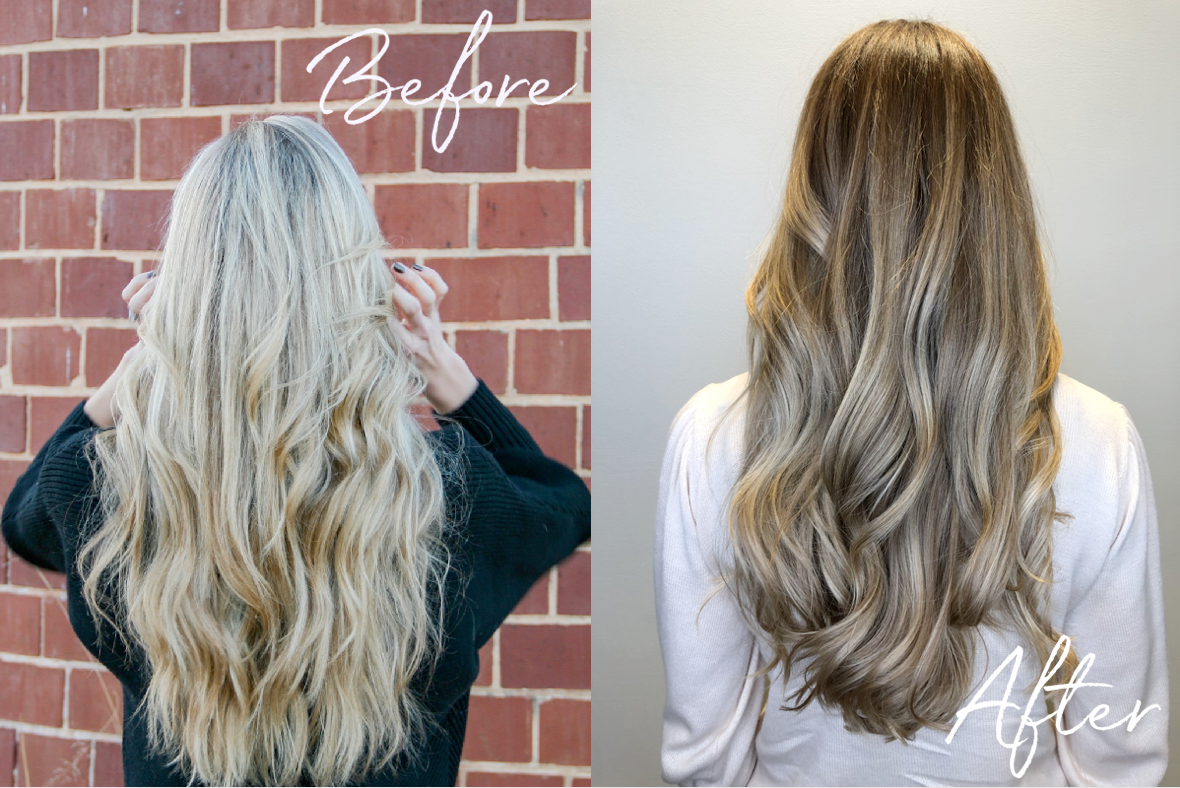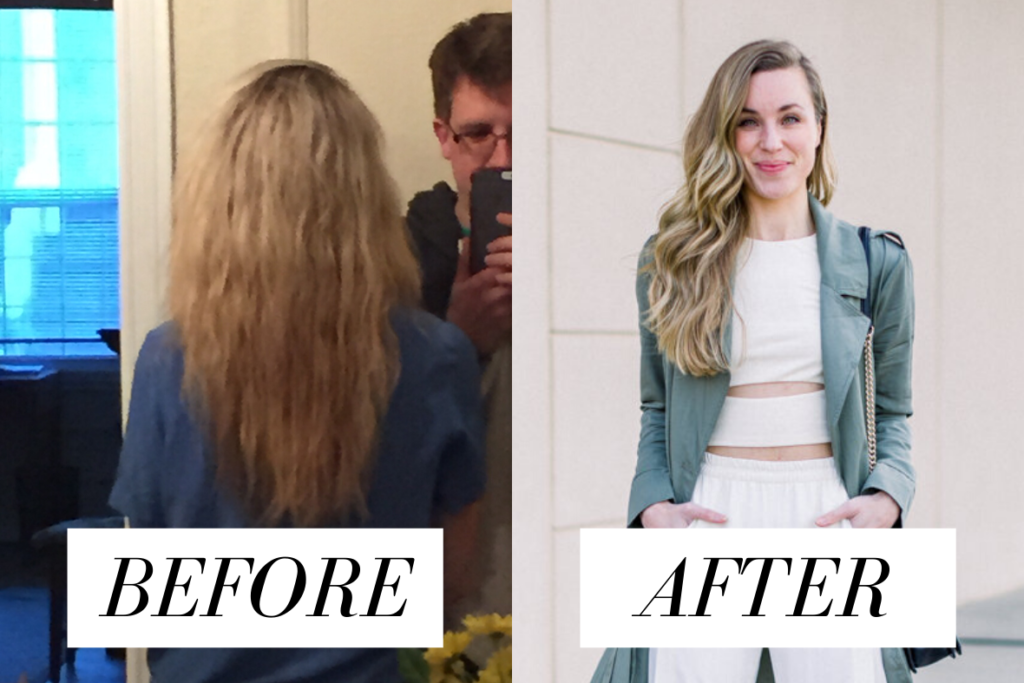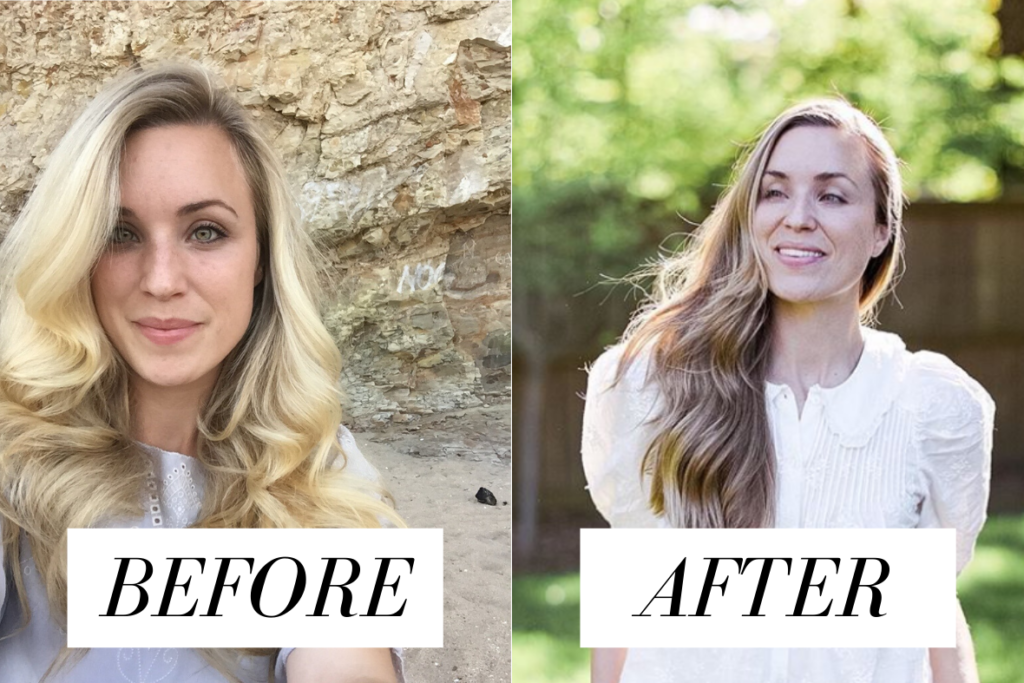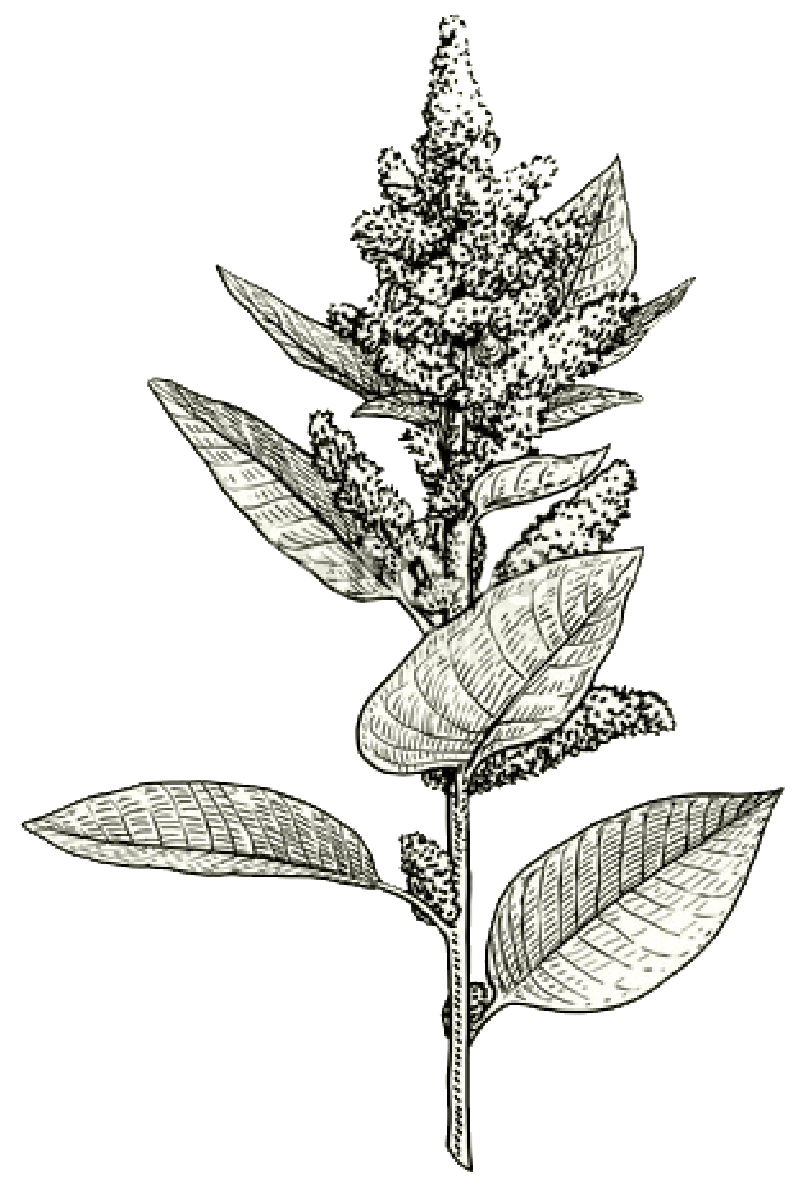
At the beginning of 2018, I started feeling a tug to go back to a natural hair color. I got my first set of highlights at age 16 and have spent over a decade experimenting with highlights and lowlights, and I even went brunette at one point. Eventually, the bleach, daily heat styling, and hair color appointment costs started to take a toll.
From having to stock up on expensive shampoos and conditioners for color-treated hair to feeling like my blonde was getting a little too blonde, I was ready to give the bleach a breather. Even though I knew it was time, I had concerns: Would I have a harsh line of demarcation from the grow out? Would my hair look weird without highlights? What even was my natural hair color?
With the help of my hair stylist, I’m happy to say that I’ve reached the other side of the journey going back to my natural hair color (see here and here for a recent shots)! Whether you have colored hair and want to grow out your natural color or are curious about the process, I’m sharing all my best tips for going back to your natural hair color below.

1. Decide Why You’re Going Natural
The signals that it’s time to go back to your natural color can be obvious or subtle. For me, they were both. Here’s a shortlist of signs it’s time to relax with the coloring and go natural for a while:
Personal Reasons to Go Natural
• Your yearly salon bills are piling up, and you’re tired of it.
• You’re bored with your current color.
• You don’t have the time or energy required to maintain your current shade.
• You don’t know what your natural hair color is and want the refreshing feeling of growing it out.
• You’re going through a life transition and need a change of pace.
Hair Health-Related Reasons to Go Natural
• Your hair’s health has taken a beating (dry ends, very porous, etc.).
• Your hair was damaged in a previous coloring appointment.
• Your hair no longer compliments your skin tone or eyebrows. You can fix your brows with brow tint or brow lamination from certified estheticians from a good spa like this brow studio in Calgary.
• Your hair color generally looks fake (too platinum, etc.).
2. Ask Your Stylist for a Plan
Most people are able to identify that they’re ready to return to their natural color on their own but don’t know where to go from there. Once you’ve made the decision, I highly recommend that you speak to a hair professional.
My stylist made me feel more comfortable about the grow out and came up with a plan for returning to my natural hue that I trusted wouldn’t leave me with a harsh grow out line, damage my hair, or be crazy expensive.
3. Be Strategic with Your Last Coloring
It may sound counter-intuitive, but coloring your hair one last time before you decide to stop coloring is crucial. Confused? Here’s why.
The reason I decided to stop coloring my hair altogether is that my last full highlight (which was by a local stylist I’d never seen) left my hair over-processed and seriously damaged. Rather than do a color correction, I decided to grow it out.
I went crawling back to my original stylist for a fix, and she recommended one last strategic coloring to encourage the growth to look as natural as possible. Here’s what she did:
1. Light, Well-Placed Balayage: Strategically break up some of the chunky highlights around my face with 5 to 10 subtle foils at my next appointment.
2. Leave It Alone: After that, it was cuts only (no color) for 8+ months. But if you’d like to have fun trying different hair colors, I recommend using hair extensions like these vixen sew in dallas.
Because I did this, my new, darker roots faded seamlessly into my colored hair’s ends. This allowed me to completely grow out my hair without touch ups.
3. Use High-Quality Products
If you’re going natural, your haircare regimen should be a lot like your skincare regimen: simple, consistent, and results-oriented. See this as a chance to nourish hair that’s been over-processed, treated harshly, or neglected.
Here’s the “capsule” of products and routines I recommend while growing out your natural hair color:
• Using a wide-tooth comb in lieu of a traditional hairbrush for detangling has reduced my breakage dramatically. I use this detangling primer for a smooth, silky finish.
• Air dry often or use a heat-controlled hair dryer, like the Dyson (read my honest Dyson dryer review here).
• Invest in a sulfate-free shampoo and nourishing conditioner.
• Apply a weekly mask to improve hair strength, shine, and softness.
To learn more about what I use, do, and don’t do to keep my strands healthy, read my 7 tips and tricks for long, healthy hair.
Shop My Healthy Hair Essentials
4. Accept the Growth or Chop It Off
When I started having my photograph taken every week for the blog, I noticed the grow out more than ever. While bothersome, I knew that summer was right around the corner and my hair would naturally lighten up.
It pays to be patient rather than get back into the same old cycle of coloring over and over again. For perspective, it took about 18 months for my old blonde highlights to be completely gone.
That being said, if you’re too impatient for the dye to go, you can get rid of it by simply cutting it off. Whether a cropped pixie or chin-length bob, there are plenty of flattering and chic hairstyles that are short or medium in length.
5. Take a Hair Growth Supplement
On average, hair grows about .5″ per month, but whether yours grows faster or slower is entirely genetic. My hair grows slow, so I took a hair growth supplement throughout the grow-out period.
This biotin hair vitamin really works and has done wonders for my hair and nails. I also tried to keep my diet high in rich, bright, colorful vegetables and fruits to encourage hair growth.
6. Use Self Tanner
Self-tanner for natural hair growth? Not exactly. However, as a blonde, I promise you’ll feel better about going from highlighted blonde to your natural hair color if tanning is part of your routine.
Something about the tone of my natural hair color (which is a honey bronde tone) wasn’t too flattering against my (very pale) winter skin. To get through these long winter and early spring days when my skin didn’t have color, I used using these facial tan drops.
It’s amazing what adding a bit of tone does to improve the overall look of my hair and complexion. I shared my full list of recommendations for a natural bronze glow in this post.
Before and After Photos from my Journey
Just for fun, here are some more before and afters!



Thankfully, Natural Hair Color is in Style
Whether you’re wondering, “Should I go back to my natural hair color?” or have already decided to grow it out, here’s an encouraging note—natural hair color is actually very “in” right now!
There is tons of inspiration and motivation out there to get you excited about the process. If you’re nervous, keep in mind that color is right there if I ever decide I want to be blonde again.
If I do decide to lighten my strands, they’ll be in a much healthier place than they were 1-2 years ago—it’s a hair win-win, if you ask me!
What’s your biggest fear with going back to your natural hair color? Any questions or concerns? I’d love to help! Feel free to leave a comment or send me a direct message on Instagram with your questions. xo!



That’s a good idea to take some supplements if you decide to go back to your natural hair color. I would think that would make it a smoother transition. I’ll have to make sure to do that if I dye my hair.
It absolutely makes a big difference!
Hi!
I want to go back to my natural hair color; which is a dark brown, but… I have gray hair too 😭. Is there something you recommend for this?
Hi Lucy! That’s a great question, and I think it depends on what color your hair is currently. If you have a stylist you trust, I recommend asking them for suggestions about how to return to brown while covering your grays. That’s how I started my journey and I’m really happy with how it turned out——I would’ve had no idea what route to take without my girl’s help. If you’re going from blonde to brown you might start with lowlights and just let the brown grow back in. If you’re starting with darker brown hair, soft highlights to blend the lighter brown coming in with the darker brown you already have could be a good option. I hope this helps! xo
It’s really helpful to know that you had to get some help from your hairstylist in order to get back to your natural color. My daughter wants to go back to her natural color but we don’t know how right now. It would be helpful to find a stylist nearby that can help out and get this fixed.
It was! I highly recommend finding a local stylist. Some stylists/salons have Instagram accounts and may offer online consultations. Best of luck to you!
Awesome article with very useful tips. Thank you for writing this. I see you wrote this last year but in this pandemic I’m sure many of us have decided to grow it all out. I had pondered it for a few months (Due to dryness/no shine & a feeling of “too fake”) then quarantine happened so nothing to lose. I figure I’ll just have a few baby lights put in around my face if I don’t love it next year.
I’m glad to hear you found it helpful, Shelley! Yes, SO many people have decided to grow it out due to COVID. It’s a process, but I bet you’ll love it once it’s all said and done! And, of course, you can always go back to highlights later if you want.
Hey! I’m so happy I found this post. I keep worrying about going back to natural dirty blonde and not liking it or something. I’ve been getting highlights about 2-3 times a year for like 13 years. Looong time haha! But I miss having reeeeally soft hair like I used to. When I did nothing with it. I think it’s taking its toll a little bit. Mostly I think I just want a change and I want to be able to embrace my natural hair. Thanks for the awesome post. 😊
I’m SO happy you found the post Madison! It is a long process, but I promise it’s worth it in the end. The “in between” phase is the hardest when the highlights are growing out but the softness + natural hair color is the best feeling in the world! Keep me posted on your progress! My IG is @natalie.yerger.
How long did this take? I am just now starting to grow my hair out!
Hey Sophia! I’d say all in all the entire process took about a year. By that I mean that I felt really happy with the natural color and the grow out after that amount of time—there’s definitely an in-between period that feels tough, but once it’s done it’s SO worth it. I should also mention that my hair grows pretty slow, so your process might be faster! And a great stylist can make it go “quicker” by toning down your current highlights, giving your great cuts, etc. 🙂 Hope that helps!
So I have gotten full set of platinum highlights for about 7 months now and my hair is super brittle at the ends and just looks unhealthy and I want to go back to a more natural honey blonde color is that possible?
Hi Sarah! To be honest, it’s hard to tell without seeing your hair in a picture or in person. Does your stylist know about your desire to go more natural? If you’re looking for some immediate TLC for your hair I recommend an Oribe mask (expensive but worth it). I went from bright, bright blonde to my natural color (dirty, honey blonde), so it’s definitely possible. The steps/path for you will depend on where your hair is now and what your natural hair color is. Check in with your stylist, if you trust him/her! xo!
Natalie, thank you for posting this! This is the best article I have found for going back to natural color from blonde. I am so tired of the maintenance but I am happy to know it is possible to go back to my natural color and it does not have to be super expensive.
So glad you found the article, Molly! I totally understand about getting tired of the maintenance. Good luck in the journey—it’s SO worth it!
I am a 21-year-old boy with light brown hair one of my friends sprayed a bunch of sun in spray in my hair to lighten it. Since I have light brown hair, it bleached it and it turned reddish. I went to Sally’s beauty where a lady told me to mix light brown and dark blonde with 20 volume developer, it took the blonde out but it made my hair copper color. three or four days past and I died it again this time medium natural brown which is a little too dark then I realized. What’s my next step to making my hair lighter? Let it grow out? Get a short hair cut? Both of these dyes were permanent
Hey Brandon, letting is grow out is always an option, but I recommend going to a professional hairstylist in your area for next steps. When I was highlighting my hair, I never did it myself, so I can’t speak much to what to do when things go wrong with box colors, etc.——seeing a professional is your best bet, I think! I hope this is helpful!
My hair was dyed purple last. I know I was having a crazy moment lol. Well that was in January and it’s now the first of November. So a lil past my ears I guess is my natural color then it looks yellowish where it goes from my natural to the faded purple color. I’ve been wearing hats and wigs while I’ve been growing it out but I’d like to be able just to go out and my hair not look a mess or not have to cover it up. Do you maybe have any suggestions? I’d truly appreciate it. I want to eventually be through with dying my hair all together. I never dyed it till my late thirties and I’m 42 and believe me I definitely experimented. I truly want to be done. I know I could cut the color off but I hate short hair and it’s taken a long time to grow it back out since I damaged it and had to cut it all off. I’m just lost on what I might can do. I mean I thought about bleaching the purple part and matching it to my natural dirty blonde color but scared to go there. So if you could help in anyway like I said I would truly appreciate it. Thanks so much and your hair looks so awesome.
Hi Tabitha! Purple—you are brave! Oh man, I wish I had some advice but this might be a little bit out of my wheelhouse. Have you considered going to a reputable stylist in your area for a color consultation? I don’t think bleach is the way to go, and growing it out to cut it would obviously be the “safest” but also takes time. If there is a way to neutralize or remove the purple without bleach, that’s what I would do. And make sure you’re drinking plenty of water and eating healthfully to encourage the growth! Sorry I can’t be of more help!
Nice read. I’d like to like my real dirty blonde hair so think the mask idea is great to sort of actively appreciate it.
So glad to hear you found it helpful!
Your natural hair color is gorgeous!! I love this too. I’ve been trying to decide what to do with my hair and getting worn out from the upkeep of dying it so often. This inspires me to go with the natural look! Thank you for sharing your journey!
What hair growth supplements do you use?
Hi! I used to take biotin but learned (postpartum) from a hair specialist that a round of that can actually stunt future, so I just try to eat healthy and drink lots of water! And not stress. 🙂